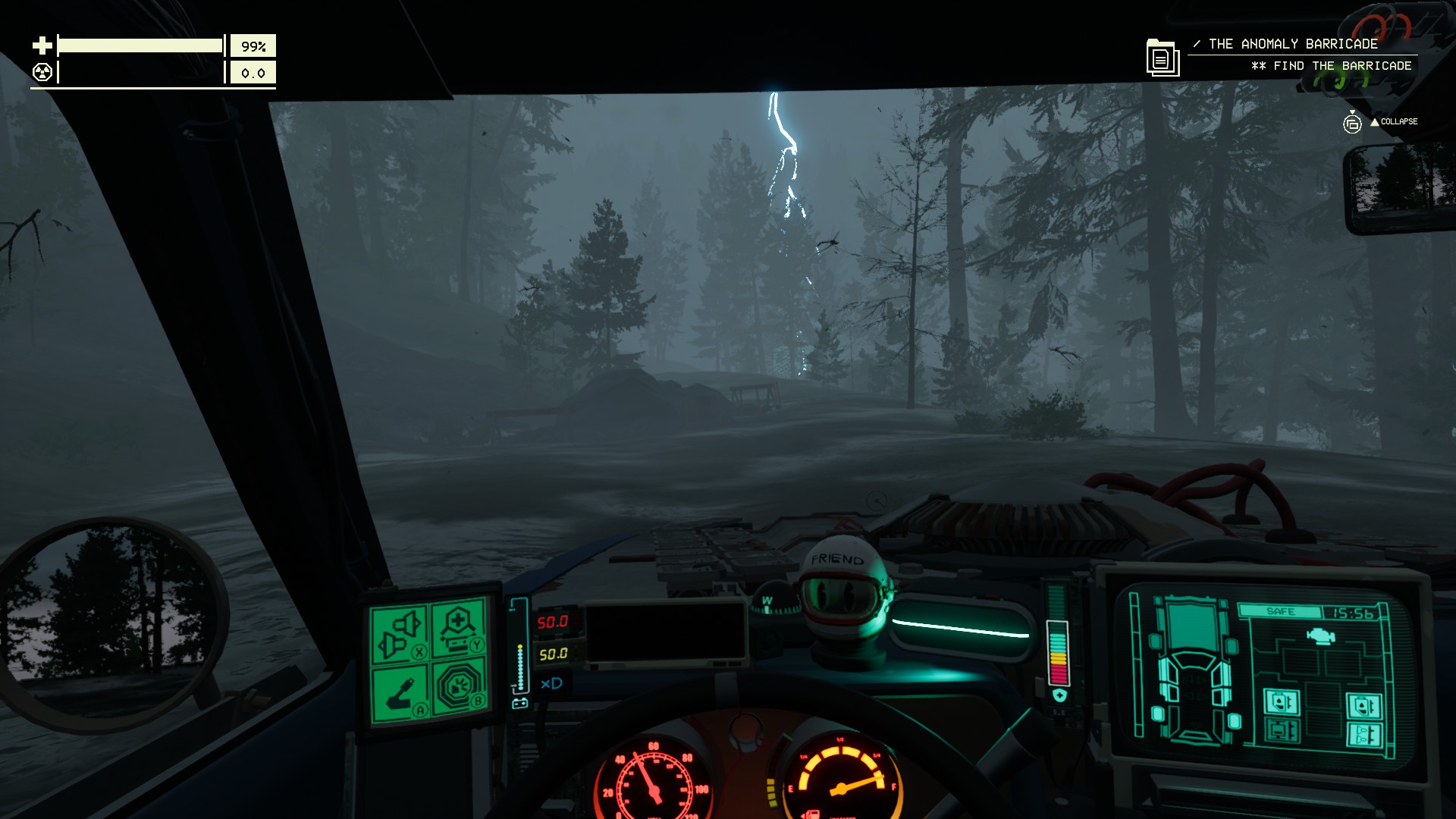In Pacific Drive, you are a delivery driver who gets sucked into an unmarked area of the Pacific Northwest known as the “Olympia Exclusion Zone.” This zone encompasses hundreds of square miles of temperate rainforest and swamplands, and as one might expect from a game wearing its influences – like The Southern Reach Tetralogy by Jeff VanderMeer and the S.T.A.L.K.E.R. series from GSC Game World – on its sleeve, your entire goal is survival and possibly even escape. The way you do that in this game is the interesting bit: you build a car.
Rather, you come into possession of a car-shaped “Remnant,” an artifact imbued with the energy of the Zone that allegedly drives its possessor insane over time. The car is a station wagon that’s at least 50 years old when you pick it up, and in order to navigate all the hazards each area of the Zone throws at you, you will have to modify it substantially – with research equipment, protective materials, and modules for extra fuel, storage and defensive abilities. Once you’ve built up your car to your heart’s – and parts budget’s – content, you go out on a run: scavenging, research, looking for ways into deeper areas of the Zone.
Your car is by no means invincible: while it will keep you safe from external threats, it does so at the cost of its own bodily integrity. You’re at risk of the wagon’s external paneling failing, its headlights busting, tires puncturing, engine seizing, fuel running out, battery dying, windows cracking. Every action has a cost, and that cost can result in disaster—failed runs, lost loot, scrapped missions—if you’re not prepared to pay it. Every run is broken into stages, and you’re constantly checking your route map – as well as the GPS on your dashboard – to make sure you’re not about to run into major pockets of dimensional instability. These storms will wreck your car and ruin your day if you’re caught unawares. As you get a better feel for the game, you start to keep one eye on the road and one eye on your GPS, just in case anything bad pops up.
And so this is the loop: start in the garage, build and rebuild your car, then go out on a run for parts or progression, make it back to the garage (in a frantic sprint towards a LIM Gateway whose activation usually results in all hell breaking loose around you), rinse and repeat. If you have a surplus of materials and energy, you can buy upgrades and transform your car into an indomitable armored research station.
It took me about 25 in-game hours to realize that what I was building was a Dominator.

“The Dominator” is the name given to a series of armored research vehicles kitbashed out of various SUVs and pickup trucks. The first Dominator was a Chevy Tahoe; the currently operational model, the Dominator 3, was molded out of a 2012 Ford F-350 Super Duty. In addition to the armor plating covering the entire chassis, the Dominator 3 is also equipped with hydraulic anchor spikes to aid Timmer and his team in directly intercepting tornadoes. This has allowed him to get insane footage for reality television for well over 15 years, and aid meteorologists and tornadogenesis researchers by collecting data close to the ground. He was even part of my local news station’s field reporting team for a hot second.
Timmer is maybe the most publicly-recognizable storm chaser in the world; Glen Powell’s free-wheeling bad boy character in Twisters (2024), Tyler Owens, is based largely on Timmer. But storm chasing isn’t only about the dramatic moments when a storm is in your face, and not everyone is able to do what Timmer and his Dominators can. Sometimes – most of the time – storm chasing is hours of driving, navigating unfamiliar dirt paths and poorly-maintained pavement, constantly checking your route map and the GPS and Doppler Radar to make sure you’re not about to run into any, hmm, instability. Storm chasing can be incredibly dangerous, which is why preparation is so vital and why there are rules about how you do it. Nothing is stopping any yahoo from hopping in their 1996 Honda Civic and barging into the Oklahoma City metro area every late spring and mid-fall for a hoot, but smart chasers train first. They listen to experts. They make sure all their equipment is working before runs. They make sure their cars are in good shape. Most of the time, it’s relatively safe.
Pacific Drive replicates the feeling of chasing supercells in an uncanny way. Yes, it’s partially because you can end up with a mobile fortress like the Dominator; but mostly it’s because so much of the game is about that careful planning and tinkering and building and preparing. Making sure you have everything you need before you head out into the unstable unknown. Fixing what’s been broken. Overhauling and pivoting when your plans go awry. Hopping out of your car in the middle of a windstorm to quickly fix a broken module or patch a tire.
And when you’re back from a run, emotionally and physically exhausted from what you just experienced, that little feeling in your chest develops that migrates to your brain and nestles there, forever:
Let’s do that again.

Response
[…] No Escape explains how Pacific Drive is like storm chasing. […]